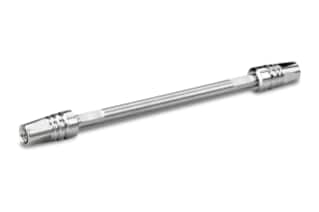
|
Chemistry |
C18 |
|
Separation Mode |
Reversed Phase |
|
Particle Substrate |
Hybrid |
|
pH Range Min |
1 pH |
|
pH Range Max |
12 pH |
|
Maximum Pressure |
18000 psi (1240 Bar) |
|
Endcapped |
Yes |
|
Silanol Activity |
Low |
|
Particle Shape |
Spherical |
|
Particle Size |
1.7 µm |
|
Endfitting Type |
Parker-style |
|
Pore Size |
130 Å |
|
Format |
Column |
|
Surface Area |
185 |
|
System |
UHPLC, UPLC |
|
Particle Technology |
BEH |
|
USP Classification |
L1 |
|
Inner Diameter |
1 mm |
|
Length |
100 mm |
|
Carbon Load |
18 % |
|
eCord |
Yes |
|
UNSPSC |
41115709 |
|
Brand |
ACQUITY UPLC |
|
Product Type |
Columns |
|
Units per Package |
3 pk |

ACQUITY UPLC BEH C18 Column, 130Å, 1.7 µm, 1 mm X 100 mm, 3/pk
The ACQUITY UPLC BEH C18 Column is made to handle a variety of chromatographic problems as well as laboratory and technical needs. The column helps to increase the resolution, sensitivity, and speed of your analysis. You can use the ACQUITY UPLC BEH C18 Column to carry out a number of research tasks, including ultra-fast analysis, increased throughput while maintaining resolution, and improved resolution while cutting down on analysis time.
The ACQUITY UPLC BEH C18 Column can be used as a general method development tool and is well suited to evaluating a wide range of analytes due to the analytical column's tri-functional bonding. With it, you may achieve astounding pH stability for all analyte kinds, low and high.
With the ACQUITY UPLC BEH C18 Column's industry-leading mobile phase pH range (1–12) and high-temperature stability (80 °C), you can obtain amazing analyses. The tri-functionally bound BEH particle on which the column is built offers the widest usable pH range (pH 1–12), superior low pH stability, and extremely reduced column bleed for high sensitivity MS applications. The retention, selectivity, and sensitivity of ionizable compounds in your system will be directly impacted by the ACQUITY UPLC BEH C18 Column. A fantastic set of results was obtained thanks to packing materials that were specially developed for use with the ACQUITY UPLC System.
To locate all your requirements and demands for conducting tests and analyses in your laboratory, you can shop for lab equipment on our website or by browsing through our comprehensive brochure.
Additionally, we recommend you to look into ACQUITY UPLC BEH C18 VanGuard Pre-column, 130Å, 1.7 µm, 2.1 mm X 5 mm, 3/pk; The 1.7 um ACQUITY UPLC BEH C18 sorbent is the most versatile column option for UPLC separations and is the leading column for method development. For high sensitivity MS applications, the tri-functionally bound BEH particle offers the greatest usable pH range (pH 1–12), improved low pH stability, and ultra-low column bleed. By immediately connecting to the ACQUITY UPLC column's intake, the VanGuard pre-column minimizes superfluous column volumes and reduces leaking by doing away with extra connections.
What Are The pH And Pressure Ranges That The ACQUITY UPLC BEH C18 Column Can Handle?
Use of the ACQUITY UPLC BEH C18 Column is secure at pressures up to 18,000 psi and a pH range of 1 to 12. (or 1240 Bar). Please note operating your experiments outside the optimal range can have detrimental impact on your Analytical Column and decrease its efficiency, performance, and lifetime.